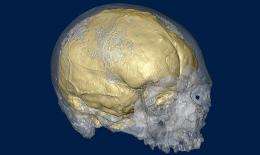March 15, 2010 weblog
Cro Magnon skull shows that our brains have shrunk

(PhysOrg.com) -- A new replica of an early modern human brain has provided further evidence for the theory that the human brain has been shrinking. The skull belonged to an elderly Cro Magnon man, whose skeleton is called Cro Magnon 1. The entire skeleton was discovered in 1868 in the Cro Magnon cave in Dordogne, France, and has since become one of the most famous Upper Palaeolithic skeletons. Using new technology, researchers have produced a replica of the 28,000-year-old brain and found that it is about 15-20% larger than our brains.
To produce the brain replica, called an endocast, the scientists first digitally scanned the interior of the empty skull. The images revealed the impression left by the brain on the neurocranium, which was then transformed into a 3D image. Software was then used to fabricate the brain endocast.
The researchers, including anthropologist Antoine Balzeau of the French Museum of Natural History, said that an initial assessment of Cro Magnon 1's skull supported the theory that brains have grown slightly smaller over the past tens of thousands of years, reversing an earlier trend toward larger brains.
The finding doesn’t suggest that humans today are less intelligent than earlier humans. Although previous studies have found a very small relationship between brain size and intelligence, many other factors affect brain intelligence.
For instance, different parts of the brain have different functions. The researchers found that the Cro Magnon brain appears to have had a smaller cerebellum - the brain region linked to motor control and language - than our brains today. The researchers explain that this finding shows that some parts of the brain are more “compressible” than others, while other regions seem to provide a benefit by growing larger.
Although scientists don’t know for sure why our overall brains are shrinking, some researchers hypothesize that our brains are becoming more efficient as they grow smaller. Having a large brain comes at a cost, so smaller brains have an advantage since they enable the body to use the extra energy for other purposes. On the other hand, perhaps a large skull had certain advantages for earlier people. One idea is that Cro Magnons needed large skulls because of the difficulty in chewing their food, which included lots of meat such as rabbits, foxes, and horses. Since our food has become easier to eat, we don’t need such large skulls or jaws. Another theory is that the high infant mortality rate in earlier times meant that young humans had to be physically robust (with large heads) to survive their early years.
The researchers plan to show a mold of the skull later this week at the National Museum of Natural History in Washington, DC.
More information: via: Times Online
© 2010 PhysOrg.com



















